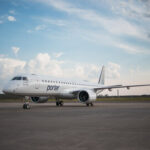Scientific Systems has successfully flown multiple flight tests of its Collaborative Mission Autonomy (CMA) software running on a live General Atomics Aeronautical Systems MQ-20 Avenger Unmanned Combat Air Vehicle.
In the November 2023 flight tests, CMA software commanded a mixed team of Live, Virtual, and Constructive (LVC) MQ-20 platforms to execute a fully autonomous multi-vehicle Defensive Counter Air mission.
The tests used a mix of LVC platforms, sensors, and effectors to encompass all aspects of a realistic, operationally relevant F2T2EA (Find, Fix, Track, Target, Engage, Assess) air combat mission, including combat air patrol, detection, identification, tracking, targeting, and engagement of multiple targets throughout multiple scenarios.
Scientific Systems’ software was embedded onboard all the live, virtual, and constructive MQ-20 platforms, successfully managing the autonomous mission at the edge to compensate for communication and coordination challenges.
Virtual and constructive elements of the scenario were modelled in the U.S. Air Force’s AFSIM (Advanced Framework for Simulation, Integration, and Modelling software environment).
In support of these November flight tests, collaborative autonomy behaviours from Scientific Systems and other organisations were integrated into and orchestrated using a GFE (government-furnished equipment) autonomy software architecture enhanced by GA-ASI.
Scientific Systems’ Collaborative Mission Autonomy (CMA) software consists of AI (Artificial Intelligence) and ML (Machine Learning)-driven software for coordinating multi-vehicle decentralised mission execution.
Scientific Systems’ algorithms use operator pre-mission inputs to generate tailored, coordinated flight behaviours that address mission objectives by optimising aircraft positioning, engagement parameters, and defensive manoeuvres.
In-flight optimisation algorithms allow the CMA-driven uncrewed team to autonomously replan and re-coordinate their tasking and positioning, even when disconnected from their human operators, to account for dynamically changing mission constraints.
In previous demonstrations, CMA handled a variety of unpredictable in-flight circumstances and contingencies such as communication outages, lost teammates, and enemy threat positioning.
Subscribe to the FINN weekly newsletter

